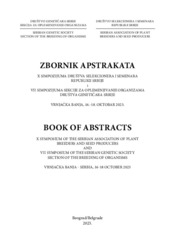Приказ основних података о документу
Primena AMMI modela u selekciji dvoredih ječmova
Application of AMMI model in the selection of two-row barley
| dc.creator | Bratković, Kamenko | |
| dc.creator | Luković, Kristina | |
| dc.creator | Perišić, Vladimir | |
| dc.creator | Perišić, Vesna | |
| dc.creator | Madić, Milomirka | |
| dc.creator | Savić, Jasna | |
| dc.creator | Maksimović, Jelena | |
| dc.date.accessioned | 2023-10-27T13:00:56Z | |
| dc.date.available | 2023-10-27T13:00:56Z | |
| dc.date.issued | 2023 | |
| dc.identifier.isbn | 978-86-87109-17-9 | |
| dc.identifier.uri | http://RIVeC.institut-palanka.rs/handle/123456789/757 | |
| dc.description.abstract | Interakcija genotipa i spoljašnje sredine (GEI) je kompleksan problem koji komplikuje proces selekcije i oplemenjivanja ratarskih kultura te je stoga važno utvrditi njenu značajnost i iskoristiti njene pozitivne karakteristike. U radu je analiziran prinos zrna dvadeset genotipova ozimog dvoredog ječma u šest spoljašnjih sredina (dve vegetacione sezone na tri lokaliteta). Za analizu interakcije korišćen je linearni mešoviti model i model glavnih efekata i višestruke interakcije (AMMI) sa AMMI1 biplot prikazom. Utvrđena je visoka statistička značajnost interakcije dok je AMMI1 model objasnio 40.1% varijacije interakcije. Stabilnost genotipova određena je parametrima stabilnosti AMMI modela (AMMI1, AMMI2 i ASV) i utvrđena je značajna korelacija rangova genotipova između njih. Prinos nije pokazao značajnu korelaciju ni sa jednim parametrom. Na osnovu Genotip Selekcionog Indeksa (GSI), genotipovi J-82, J-103, NS-589 i J-176 su izdvojeni kao široko adaptabilni i superiorni u pogledu prinosa i stabilnosti što je potvrđeno i biplot prikazom. Genotipovi koji su na osnovu AMMI1 procenjenih vrednosti prinosa preporučeni za svaki od lokaliteta su najprinosniji NS-525, NS-593, J-176, NS-589, J-103 i J-82. Razlike u interakcijskom efektu između godina (Zemun Polje i Zaječar) kao i slab diskriminatorski efekat (Kragujevac) ne izdvajaju ni jedan lokalitet kao pogodnu test lokaciju. Winner pristupom, sve ispitivane sredine možemo smatrati kao jednu mega-sredinu što ukazuje da u ogledu dominiraju nepredvidive interakcije što specifične adaptacije čini manje značajnim. AMMI1 model je pouzdan i informativan u interpretaciji interakcije i ništa se značajno neće promeniti ako se druga interakcijska komponenta naknadno uključi. Izdvojene su neke inbred linije ječma što ovaj model čini pogodnim u selekciji perspektivnih genotipova. | sr |
| dc.description.abstract | Genotype by environment interaction (GEI) is a complex problem which complicates the selection and breeding process of field crops, and therefore it is important to determine the significance and take advantage of GEI. The paper analyzed the grain yield of twenty genotypes of winter two-row barley in six environments (two growing seasons in three localities). A linear mixed model and additive main effects and multiplicative interaction (AMMI) model with AMMI1 biplot display were used for interaction analysis. High statistical significance GEI was determined and AMMI1 model was explain 47% of interaction. The stability of the genotypes was estimated by different AMMI stability parameters (AMMI1, AMMI2 and ASV) and a significant correlation was established between them. Grain yield and stability were not related. Genotypes J-82, J-103, NS-589 and J-176 were selected as superior and wide adaptability using Genotype Selection Index (GSI). They highlight as stable and high yielding which was agreement with results of biplot analysis. On based AMMI1 estimates of grain yield, the genotypes recommended in each of the localities were the most yielding NS-525, NS-593, J-176, NS-589, J-103and J-82. The difference in the interaction effect by year (Zemun Polje and Zaječar) and weak discriminating effect (Kragujevac) does not sepatare any suitable test location. By winner approach, all the examined environments can be considered as one mega-environment, which indicates that unpredictable interactions dominate in this research, due to which specific adaptations were not of high importance. AMMI1 model is reliable and informative in the interpretation of the GEI which indicates that essentially nothing happens when the second interaction axis is subsequently included. Some inbred lines of barley have stood out, which makes this model suitable for the selection of perspective genotypes. | sr |
| dc.language.iso | sr | sr |
| dc.language.iso | en | sr |
| dc.publisher | Beograd : Društvo genetičara Srbije | sr |
| dc.relation | info:eu-repo/grantAgreement/MESTD/Technological Development (TD or TR)/31054/RS// | sr |
| dc.rights | openAccess | sr |
| dc.source | Book of abstracts : X symposium of the Serbian Association of Plant Breeders and Seed Producers and VII symposium of the Serbian genetic society Section of the breeding of organisms Vrnjačka Banja - Serbia, 16-18 October | sr |
| dc.subject | dvoredi ječam | sr |
| dc.subject | prinos zrna | sr |
| dc.subject | multivarijaciona analiza | sr |
| dc.subject | stabilnost | sr |
| dc.subject | adaptabilnost | sr |
| dc.subject | two-row barley | sr |
| dc.subject | grain yield | sr |
| dc.subject | multivariate analysis | sr |
| dc.subject | stability | sr |
| dc.subject | adaptability | sr |
| dc.title | Primena AMMI modela u selekciji dvoredih ječmova | sr |
| dc.title | Application of AMMI model in the selection of two-row barley | sr |
| dc.type | conferenceObject | sr |
| dc.rights.license | ARR | sr |
| dc.citation.epage | 128 | |
| dc.citation.spage | 127 | |
| dc.identifier.fulltext | http://RIVeC.institut-palanka.rs/bitstream/id/2423/VBanja08.pdf | |
| dc.identifier.rcub | https://hdl.handle.net/21.15107/rcub_rivec_757 | |
| dc.type.version | publishedVersion | sr |


